ANP 2: Exploring Evidence-Based Practice, Research, and Managed Care
VerifiedAdded on 2022/08/19
|8
|1681
|13
Report
AI Summary
This report, prepared for an Advanced Nurse Practitioner (ANP 2) course, differentiates between evidence-based practice (EBP) and research, highlighting their distinct goals and methodologies. Research aims to generate new information or validate existing knowledge through systematic scientific reviews, while EBP focuses on applying the best available evidence, clinical expertise, and patient preferences to make informed healthcare decisions. The report emphasizes the importance of EBP and its application in improving patient outcomes through health informatics and data mining, which can enhance efficiency, identify at-risk patients, and improve research. It then discusses managed care strategies as a form of health insurance and their role in providing care at reduced costs, including the involvement of healthcare professionals and stakeholders. The report also examines the Agency for Healthcare Research and Quality (AHRQ) quality indicators and their application in evaluating the quality of care, including preventive, inpatient, patient safety, and pediatric quality indicators.
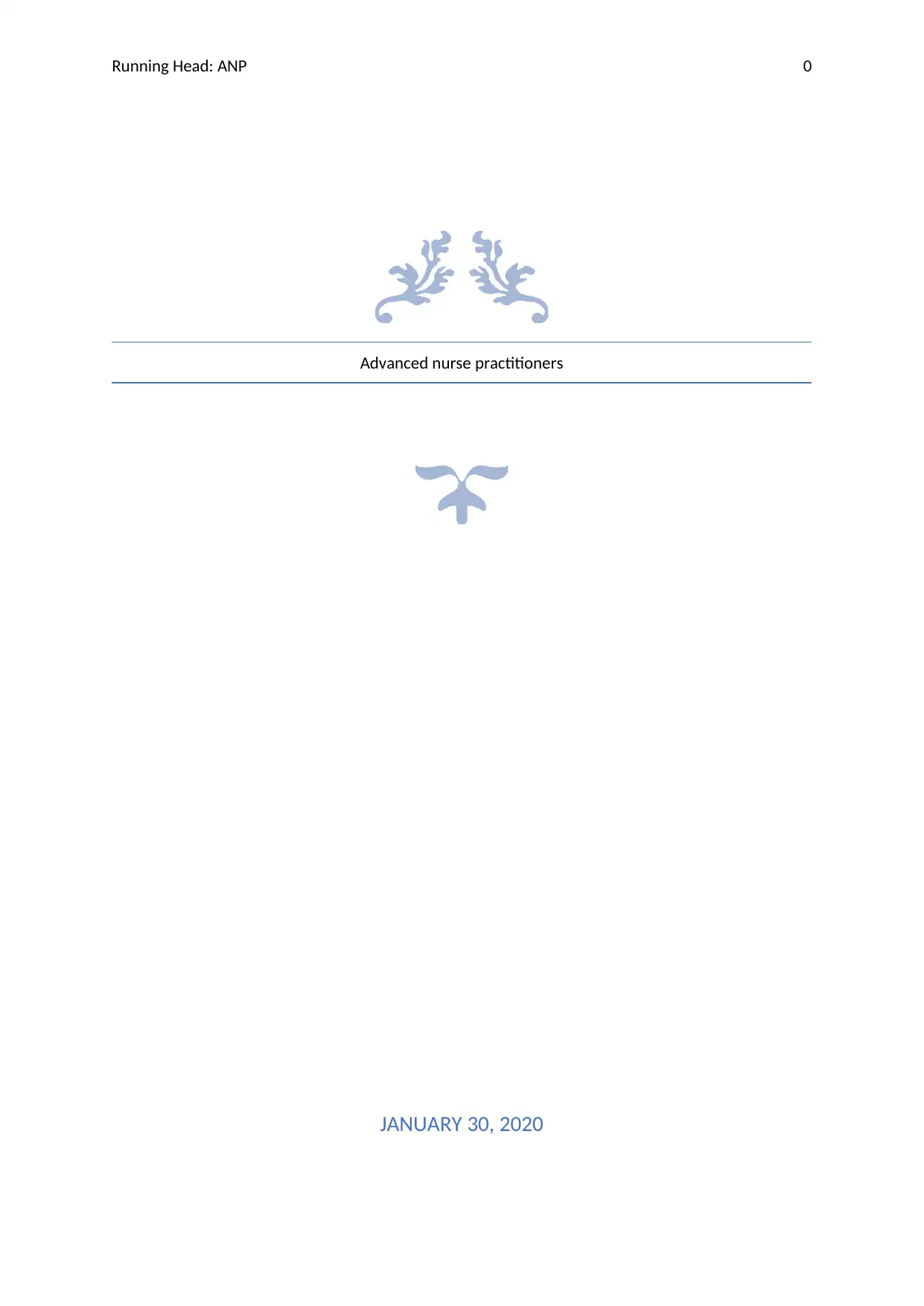
Running Head: ANP 0
Advanced nurse practitioners
JANUARY 30, 2020
Advanced nurse practitioners
JANUARY 30, 2020
Paraphrase This Document
Need a fresh take? Get an instant paraphrase of this document with our AI Paraphraser
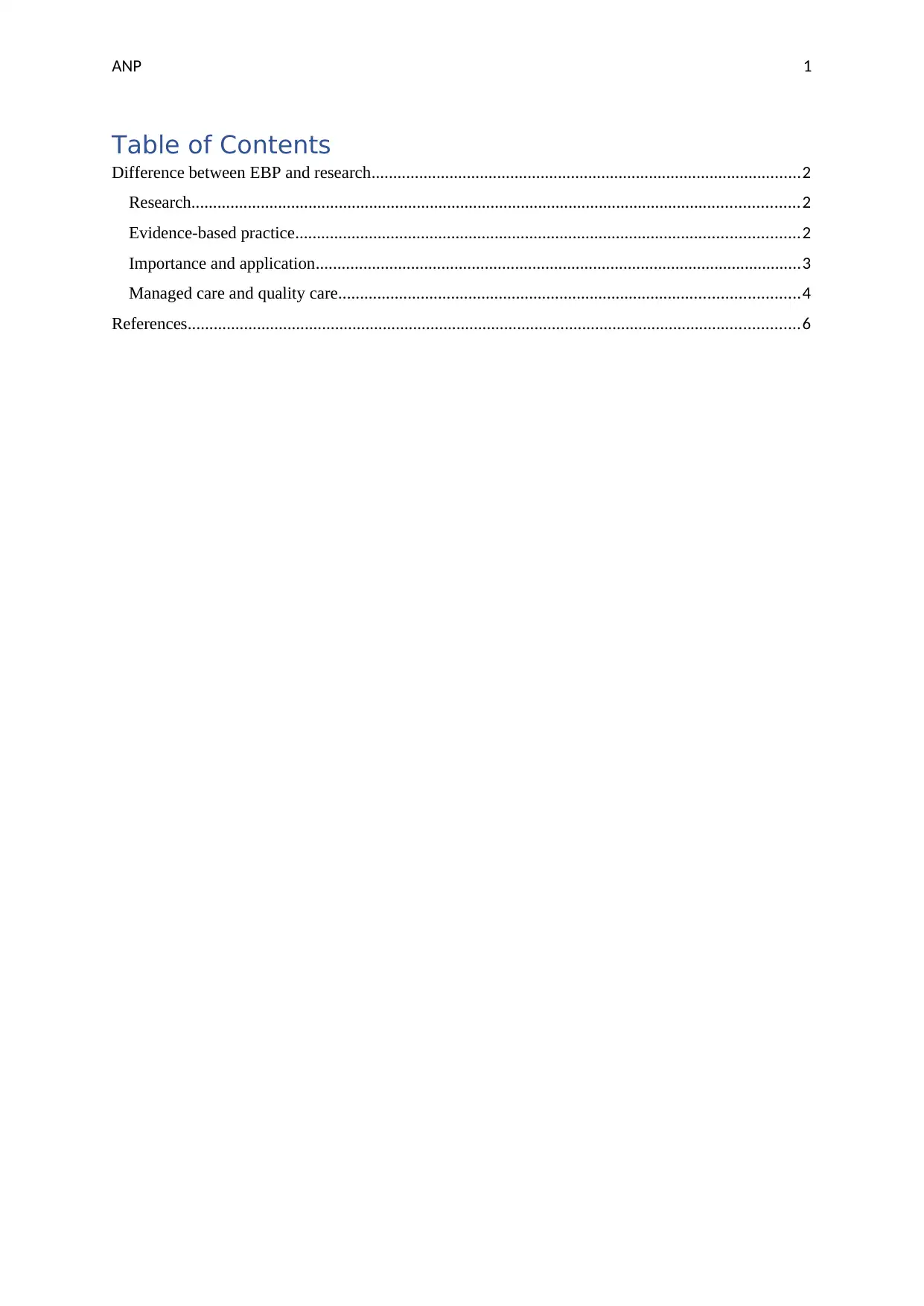
ANP 1
Table of Contents
Difference between EBP and research...................................................................................................2
Research............................................................................................................................................2
Evidence-based practice....................................................................................................................2
Importance and application................................................................................................................3
Managed care and quality care..........................................................................................................4
References.............................................................................................................................................6
Table of Contents
Difference between EBP and research...................................................................................................2
Research............................................................................................................................................2
Evidence-based practice....................................................................................................................2
Importance and application................................................................................................................3
Managed care and quality care..........................................................................................................4
References.............................................................................................................................................6
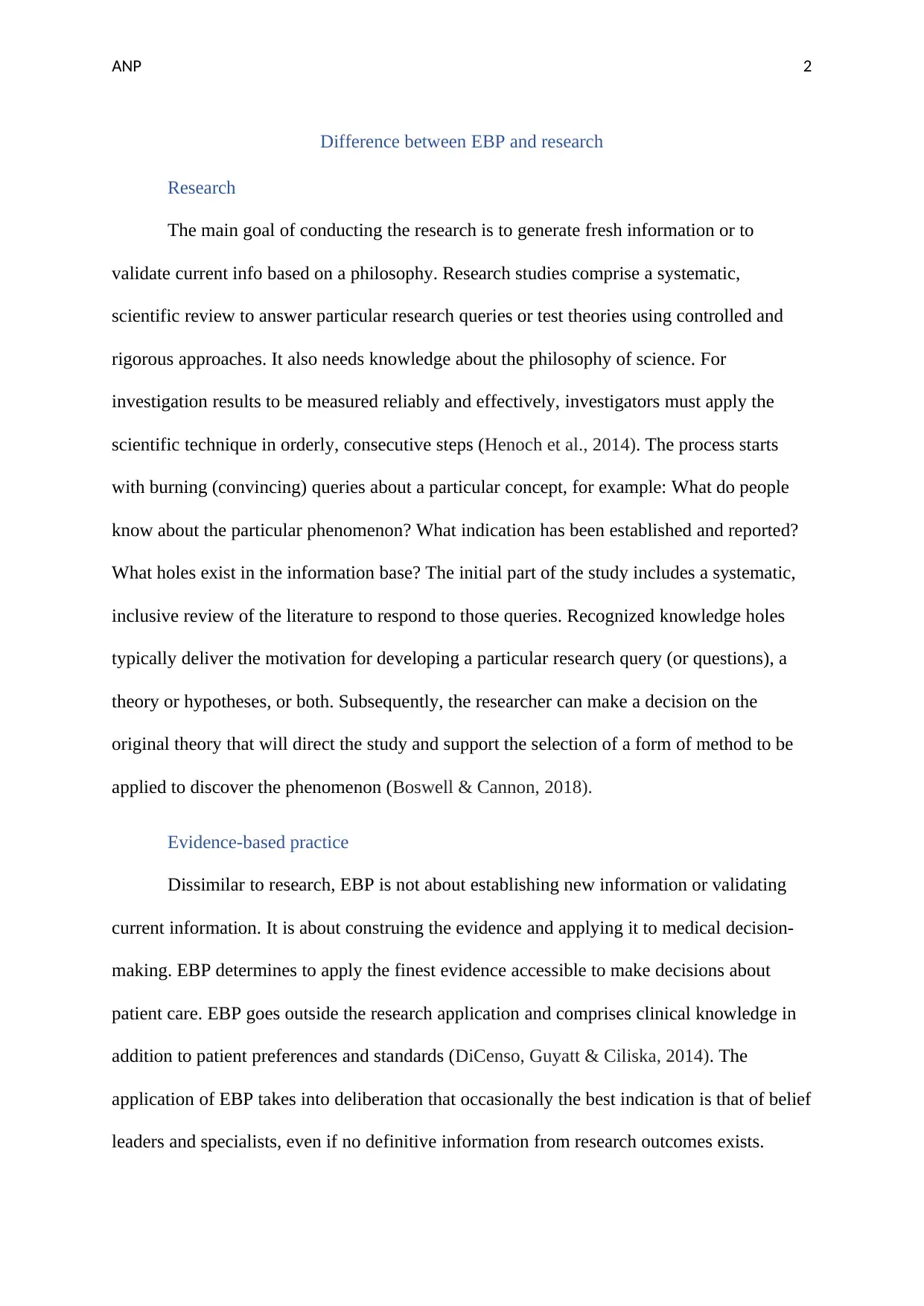
ANP 2
Difference between EBP and research
Research
The main goal of conducting the research is to generate fresh information or to
validate current info based on a philosophy. Research studies comprise a systematic,
scientific review to answer particular research queries or test theories using controlled and
rigorous approaches. It also needs knowledge about the philosophy of science. For
investigation results to be measured reliably and effectively, investigators must apply the
scientific technique in orderly, consecutive steps (Henoch et al., 2014). The process starts
with burning (convincing) queries about a particular concept, for example: What do people
know about the particular phenomenon? What indication has been established and reported?
What holes exist in the information base? The initial part of the study includes a systematic,
inclusive review of the literature to respond to those queries. Recognized knowledge holes
typically deliver the motivation for developing a particular research query (or questions), a
theory or hypotheses, or both. Subsequently, the researcher can make a decision on the
original theory that will direct the study and support the selection of a form of method to be
applied to discover the phenomenon (Boswell & Cannon, 2018).
Evidence-based practice
Dissimilar to research, EBP is not about establishing new information or validating
current information. It is about construing the evidence and applying it to medical decision-
making. EBP determines to apply the finest evidence accessible to make decisions about
patient care. EBP goes outside the research application and comprises clinical knowledge in
addition to patient preferences and standards (DiCenso, Guyatt & Ciliska, 2014). The
application of EBP takes into deliberation that occasionally the best indication is that of belief
leaders and specialists, even if no definitive information from research outcomes exists.
Difference between EBP and research
Research
The main goal of conducting the research is to generate fresh information or to
validate current info based on a philosophy. Research studies comprise a systematic,
scientific review to answer particular research queries or test theories using controlled and
rigorous approaches. It also needs knowledge about the philosophy of science. For
investigation results to be measured reliably and effectively, investigators must apply the
scientific technique in orderly, consecutive steps (Henoch et al., 2014). The process starts
with burning (convincing) queries about a particular concept, for example: What do people
know about the particular phenomenon? What indication has been established and reported?
What holes exist in the information base? The initial part of the study includes a systematic,
inclusive review of the literature to respond to those queries. Recognized knowledge holes
typically deliver the motivation for developing a particular research query (or questions), a
theory or hypotheses, or both. Subsequently, the researcher can make a decision on the
original theory that will direct the study and support the selection of a form of method to be
applied to discover the phenomenon (Boswell & Cannon, 2018).
Evidence-based practice
Dissimilar to research, EBP is not about establishing new information or validating
current information. It is about construing the evidence and applying it to medical decision-
making. EBP determines to apply the finest evidence accessible to make decisions about
patient care. EBP goes outside the research application and comprises clinical knowledge in
addition to patient preferences and standards (DiCenso, Guyatt & Ciliska, 2014). The
application of EBP takes into deliberation that occasionally the best indication is that of belief
leaders and specialists, even if no definitive information from research outcomes exists.
⊘ This is a preview!⊘
Do you want full access?
Subscribe today to unlock all pages.

Trusted by 1+ million students worldwide
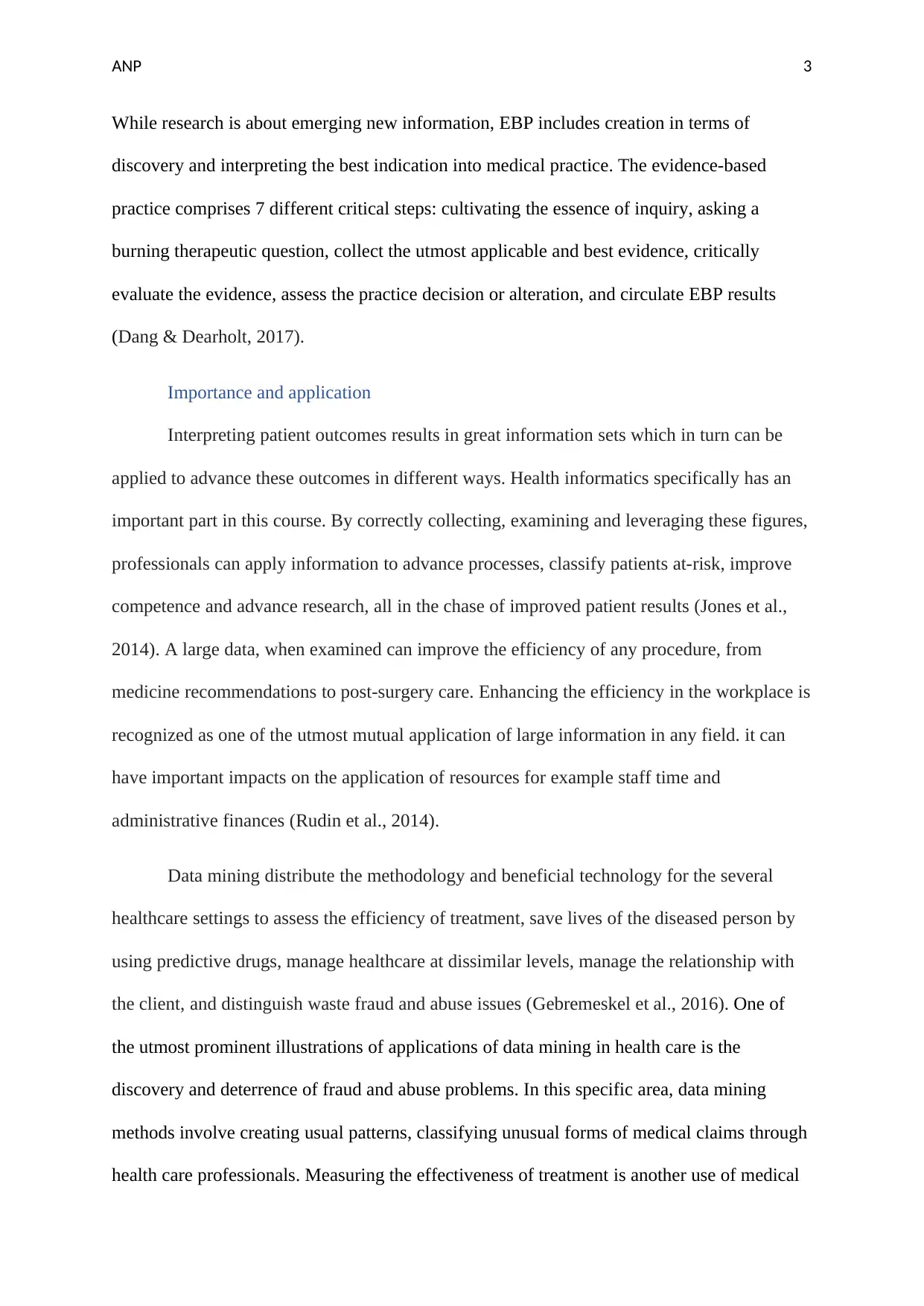
ANP 3
While research is about emerging new information, EBP includes creation in terms of
discovery and interpreting the best indication into medical practice. The evidence-based
practice comprises 7 different critical steps: cultivating the essence of inquiry, asking a
burning therapeutic question, collect the utmost applicable and best evidence, critically
evaluate the evidence, assess the practice decision or alteration, and circulate EBP results
(Dang & Dearholt, 2017).
Importance and application
Interpreting patient outcomes results in great information sets which in turn can be
applied to advance these outcomes in different ways. Health informatics specifically has an
important part in this course. By correctly collecting, examining and leveraging these figures,
professionals can apply information to advance processes, classify patients at-risk, improve
competence and advance research, all in the chase of improved patient results (Jones et al.,
2014). A large data, when examined can improve the efficiency of any procedure, from
medicine recommendations to post-surgery care. Enhancing the efficiency in the workplace is
recognized as one of the utmost mutual application of large information in any field. it can
have important impacts on the application of resources for example staff time and
administrative finances (Rudin et al., 2014).
Data mining distribute the methodology and beneficial technology for the several
healthcare settings to assess the efficiency of treatment, save lives of the diseased person by
using predictive drugs, manage healthcare at dissimilar levels, manage the relationship with
the client, and distinguish waste fraud and abuse issues (Gebremeskel et al., 2016). One of
the utmost prominent illustrations of applications of data mining in health care is the
discovery and deterrence of fraud and abuse problems. In this specific area, data mining
methods involve creating usual patterns, classifying unusual forms of medical claims through
health care professionals. Measuring the effectiveness of treatment is another use of medical
While research is about emerging new information, EBP includes creation in terms of
discovery and interpreting the best indication into medical practice. The evidence-based
practice comprises 7 different critical steps: cultivating the essence of inquiry, asking a
burning therapeutic question, collect the utmost applicable and best evidence, critically
evaluate the evidence, assess the practice decision or alteration, and circulate EBP results
(Dang & Dearholt, 2017).
Importance and application
Interpreting patient outcomes results in great information sets which in turn can be
applied to advance these outcomes in different ways. Health informatics specifically has an
important part in this course. By correctly collecting, examining and leveraging these figures,
professionals can apply information to advance processes, classify patients at-risk, improve
competence and advance research, all in the chase of improved patient results (Jones et al.,
2014). A large data, when examined can improve the efficiency of any procedure, from
medicine recommendations to post-surgery care. Enhancing the efficiency in the workplace is
recognized as one of the utmost mutual application of large information in any field. it can
have important impacts on the application of resources for example staff time and
administrative finances (Rudin et al., 2014).
Data mining distribute the methodology and beneficial technology for the several
healthcare settings to assess the efficiency of treatment, save lives of the diseased person by
using predictive drugs, manage healthcare at dissimilar levels, manage the relationship with
the client, and distinguish waste fraud and abuse issues (Gebremeskel et al., 2016). One of
the utmost prominent illustrations of applications of data mining in health care is the
discovery and deterrence of fraud and abuse problems. In this specific area, data mining
methods involve creating usual patterns, classifying unusual forms of medical claims through
health care professionals. Measuring the effectiveness of treatment is another use of medical
Paraphrase This Document
Need a fresh take? Get an instant paraphrase of this document with our AI Paraphraser
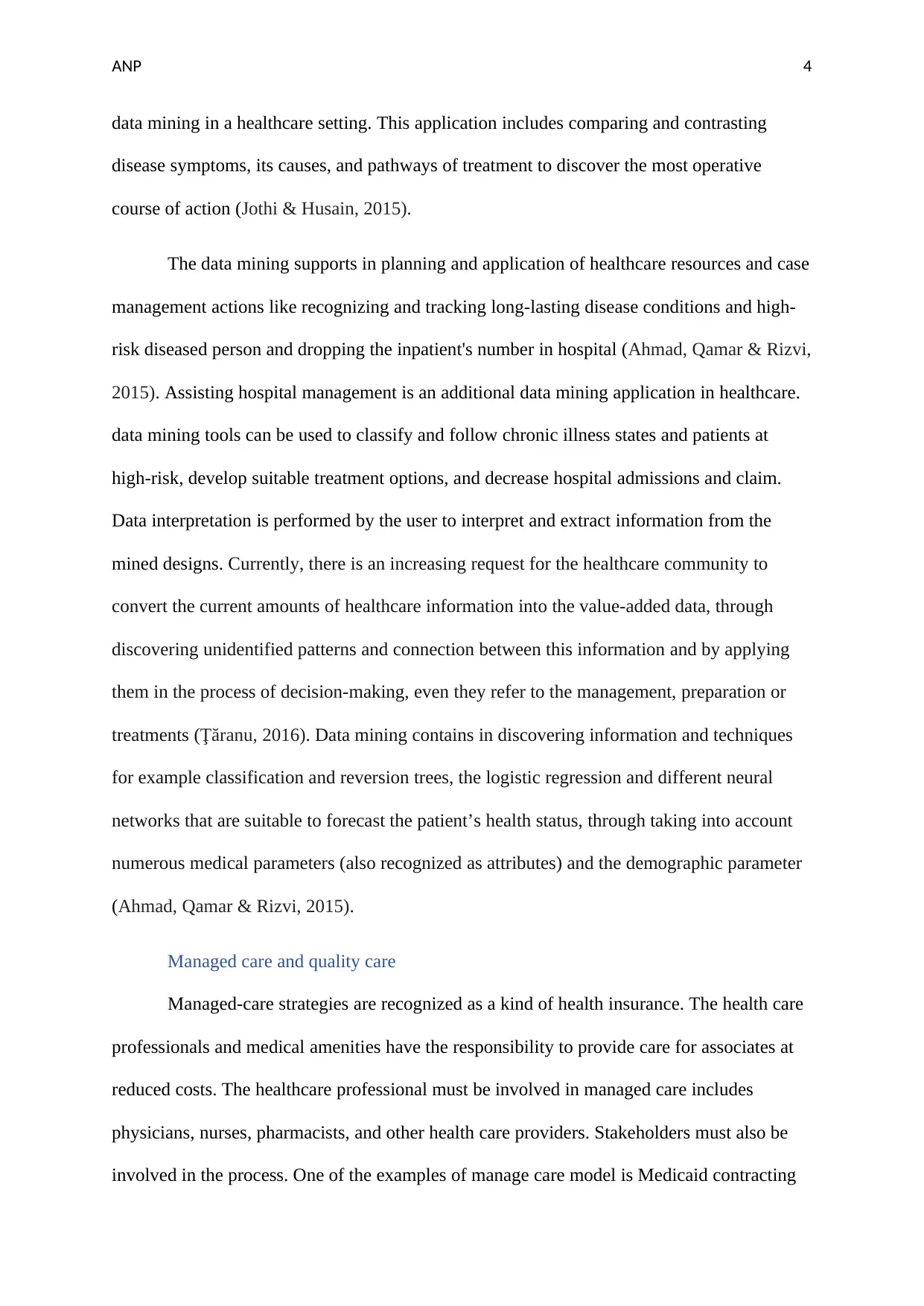
ANP 4
data mining in a healthcare setting. This application includes comparing and contrasting
disease symptoms, its causes, and pathways of treatment to discover the most operative
course of action (Jothi & Husain, 2015).
The data mining supports in planning and application of healthcare resources and case
management actions like recognizing and tracking long-lasting disease conditions and high-
risk diseased person and dropping the inpatient's number in hospital (Ahmad, Qamar & Rizvi,
2015). Assisting hospital management is an additional data mining application in healthcare.
data mining tools can be used to classify and follow chronic illness states and patients at
high-risk, develop suitable treatment options, and decrease hospital admissions and claim.
Data interpretation is performed by the user to interpret and extract information from the
mined designs. Currently, there is an increasing request for the healthcare community to
convert the current amounts of healthcare information into the value-added data, through
discovering unidentified patterns and connection between this information and by applying
them in the process of decision-making, even they refer to the management, preparation or
treatments (Ţăranu, 2016). Data mining contains in discovering information and techniques
for example classification and reversion trees, the logistic regression and different neural
networks that are suitable to forecast the patient’s health status, through taking into account
numerous medical parameters (also recognized as attributes) and the demographic parameter
(Ahmad, Qamar & Rizvi, 2015).
Managed care and quality care
Managed-care strategies are recognized as a kind of health insurance. The health care
professionals and medical amenities have the responsibility to provide care for associates at
reduced costs. The healthcare professional must be involved in managed care includes
physicians, nurses, pharmacists, and other health care providers. Stakeholders must also be
involved in the process. One of the examples of manage care model is Medicaid contracting
data mining in a healthcare setting. This application includes comparing and contrasting
disease symptoms, its causes, and pathways of treatment to discover the most operative
course of action (Jothi & Husain, 2015).
The data mining supports in planning and application of healthcare resources and case
management actions like recognizing and tracking long-lasting disease conditions and high-
risk diseased person and dropping the inpatient's number in hospital (Ahmad, Qamar & Rizvi,
2015). Assisting hospital management is an additional data mining application in healthcare.
data mining tools can be used to classify and follow chronic illness states and patients at
high-risk, develop suitable treatment options, and decrease hospital admissions and claim.
Data interpretation is performed by the user to interpret and extract information from the
mined designs. Currently, there is an increasing request for the healthcare community to
convert the current amounts of healthcare information into the value-added data, through
discovering unidentified patterns and connection between this information and by applying
them in the process of decision-making, even they refer to the management, preparation or
treatments (Ţăranu, 2016). Data mining contains in discovering information and techniques
for example classification and reversion trees, the logistic regression and different neural
networks that are suitable to forecast the patient’s health status, through taking into account
numerous medical parameters (also recognized as attributes) and the demographic parameter
(Ahmad, Qamar & Rizvi, 2015).
Managed care and quality care
Managed-care strategies are recognized as a kind of health insurance. The health care
professionals and medical amenities have the responsibility to provide care for associates at
reduced costs. The healthcare professional must be involved in managed care includes
physicians, nurses, pharmacists, and other health care providers. Stakeholders must also be
involved in the process. One of the examples of manage care model is Medicaid contracting
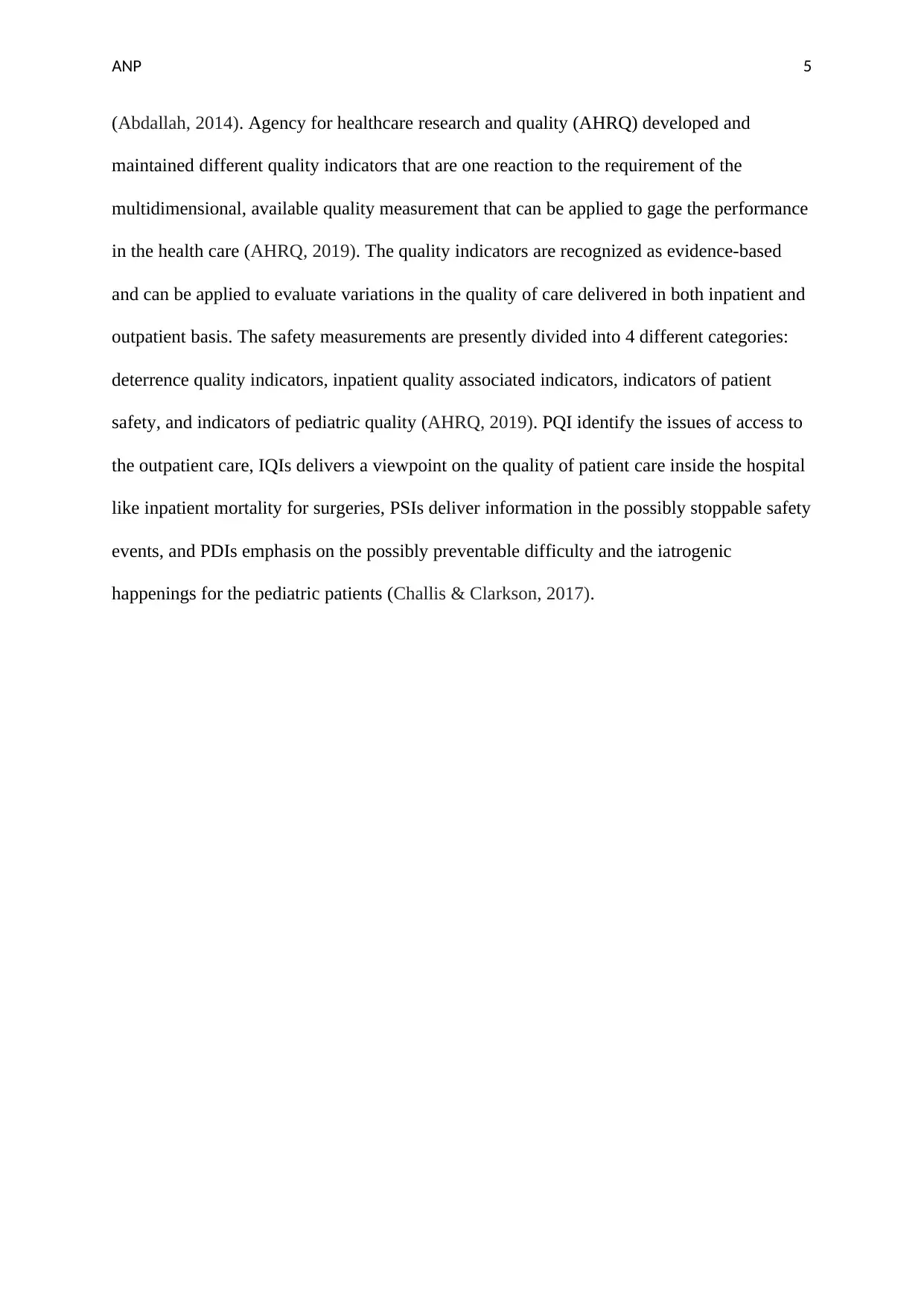
ANP 5
(Abdallah, 2014). Agency for healthcare research and quality (AHRQ) developed and
maintained different quality indicators that are one reaction to the requirement of the
multidimensional, available quality measurement that can be applied to gage the performance
in the health care (AHRQ, 2019). The quality indicators are recognized as evidence-based
and can be applied to evaluate variations in the quality of care delivered in both inpatient and
outpatient basis. The safety measurements are presently divided into 4 different categories:
deterrence quality indicators, inpatient quality associated indicators, indicators of patient
safety, and indicators of pediatric quality (AHRQ, 2019). PQI identify the issues of access to
the outpatient care, IQIs delivers a viewpoint on the quality of patient care inside the hospital
like inpatient mortality for surgeries, PSIs deliver information in the possibly stoppable safety
events, and PDIs emphasis on the possibly preventable difficulty and the iatrogenic
happenings for the pediatric patients (Challis & Clarkson, 2017).
(Abdallah, 2014). Agency for healthcare research and quality (AHRQ) developed and
maintained different quality indicators that are one reaction to the requirement of the
multidimensional, available quality measurement that can be applied to gage the performance
in the health care (AHRQ, 2019). The quality indicators are recognized as evidence-based
and can be applied to evaluate variations in the quality of care delivered in both inpatient and
outpatient basis. The safety measurements are presently divided into 4 different categories:
deterrence quality indicators, inpatient quality associated indicators, indicators of patient
safety, and indicators of pediatric quality (AHRQ, 2019). PQI identify the issues of access to
the outpatient care, IQIs delivers a viewpoint on the quality of patient care inside the hospital
like inpatient mortality for surgeries, PSIs deliver information in the possibly stoppable safety
events, and PDIs emphasis on the possibly preventable difficulty and the iatrogenic
happenings for the pediatric patients (Challis & Clarkson, 2017).
⊘ This is a preview!⊘
Do you want full access?
Subscribe today to unlock all pages.

Trusted by 1+ million students worldwide
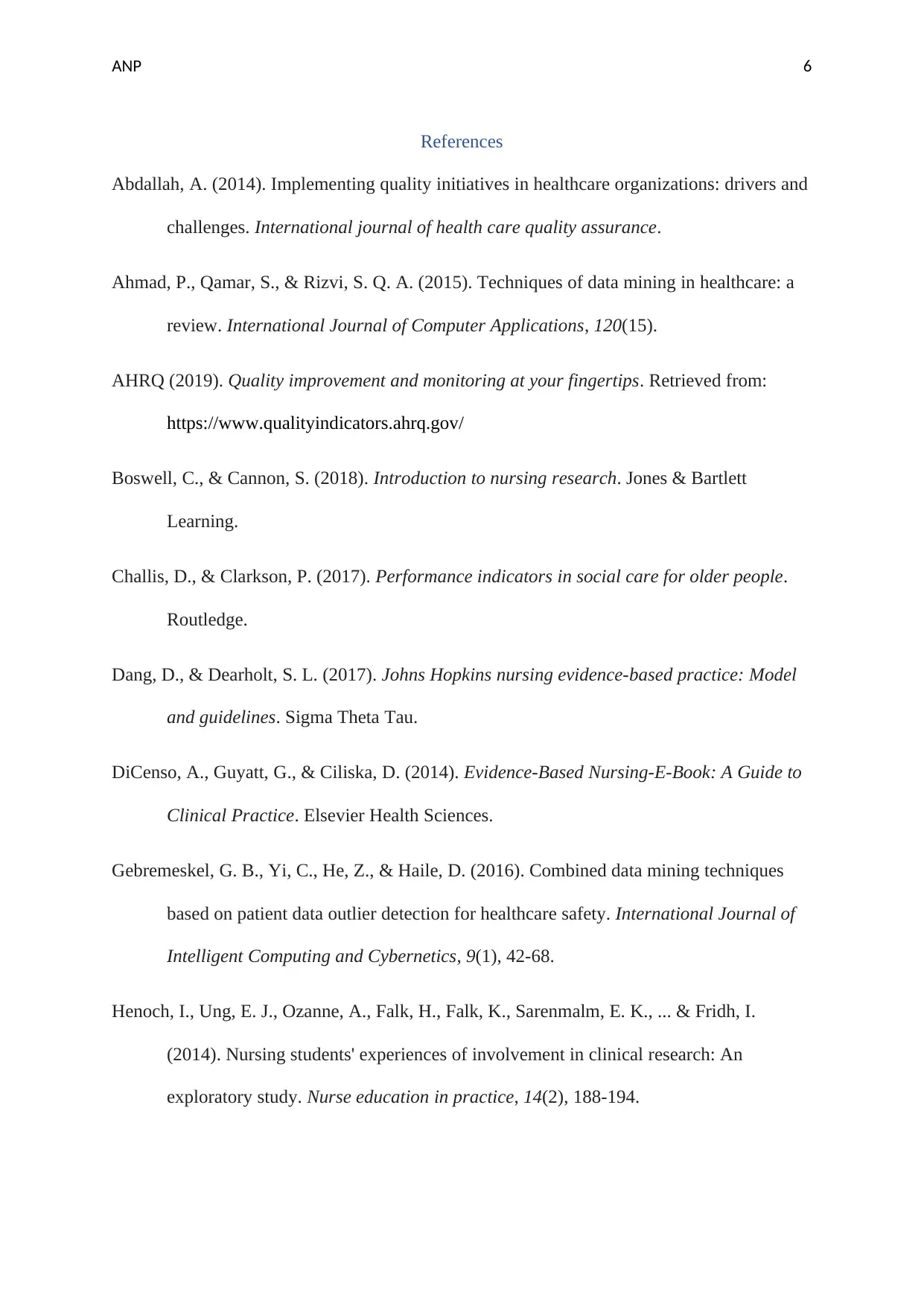
ANP 6
References
Abdallah, A. (2014). Implementing quality initiatives in healthcare organizations: drivers and
challenges. International journal of health care quality assurance.
Ahmad, P., Qamar, S., & Rizvi, S. Q. A. (2015). Techniques of data mining in healthcare: a
review. International Journal of Computer Applications, 120(15).
AHRQ (2019). Quality improvement and monitoring at your fingertips. Retrieved from:
https://www.qualityindicators.ahrq.gov/
Boswell, C., & Cannon, S. (2018). Introduction to nursing research. Jones & Bartlett
Learning.
Challis, D., & Clarkson, P. (2017). Performance indicators in social care for older people.
Routledge.
Dang, D., & Dearholt, S. L. (2017). Johns Hopkins nursing evidence-based practice: Model
and guidelines. Sigma Theta Tau.
DiCenso, A., Guyatt, G., & Ciliska, D. (2014). Evidence-Based Nursing-E-Book: A Guide to
Clinical Practice. Elsevier Health Sciences.
Gebremeskel, G. B., Yi, C., He, Z., & Haile, D. (2016). Combined data mining techniques
based on patient data outlier detection for healthcare safety. International Journal of
Intelligent Computing and Cybernetics, 9(1), 42-68.
Henoch, I., Ung, E. J., Ozanne, A., Falk, H., Falk, K., Sarenmalm, E. K., ... & Fridh, I.
(2014). Nursing students' experiences of involvement in clinical research: An
exploratory study. Nurse education in practice, 14(2), 188-194.
References
Abdallah, A. (2014). Implementing quality initiatives in healthcare organizations: drivers and
challenges. International journal of health care quality assurance.
Ahmad, P., Qamar, S., & Rizvi, S. Q. A. (2015). Techniques of data mining in healthcare: a
review. International Journal of Computer Applications, 120(15).
AHRQ (2019). Quality improvement and monitoring at your fingertips. Retrieved from:
https://www.qualityindicators.ahrq.gov/
Boswell, C., & Cannon, S. (2018). Introduction to nursing research. Jones & Bartlett
Learning.
Challis, D., & Clarkson, P. (2017). Performance indicators in social care for older people.
Routledge.
Dang, D., & Dearholt, S. L. (2017). Johns Hopkins nursing evidence-based practice: Model
and guidelines. Sigma Theta Tau.
DiCenso, A., Guyatt, G., & Ciliska, D. (2014). Evidence-Based Nursing-E-Book: A Guide to
Clinical Practice. Elsevier Health Sciences.
Gebremeskel, G. B., Yi, C., He, Z., & Haile, D. (2016). Combined data mining techniques
based on patient data outlier detection for healthcare safety. International Journal of
Intelligent Computing and Cybernetics, 9(1), 42-68.
Henoch, I., Ung, E. J., Ozanne, A., Falk, H., Falk, K., Sarenmalm, E. K., ... & Fridh, I.
(2014). Nursing students' experiences of involvement in clinical research: An
exploratory study. Nurse education in practice, 14(2), 188-194.
Paraphrase This Document
Need a fresh take? Get an instant paraphrase of this document with our AI Paraphraser
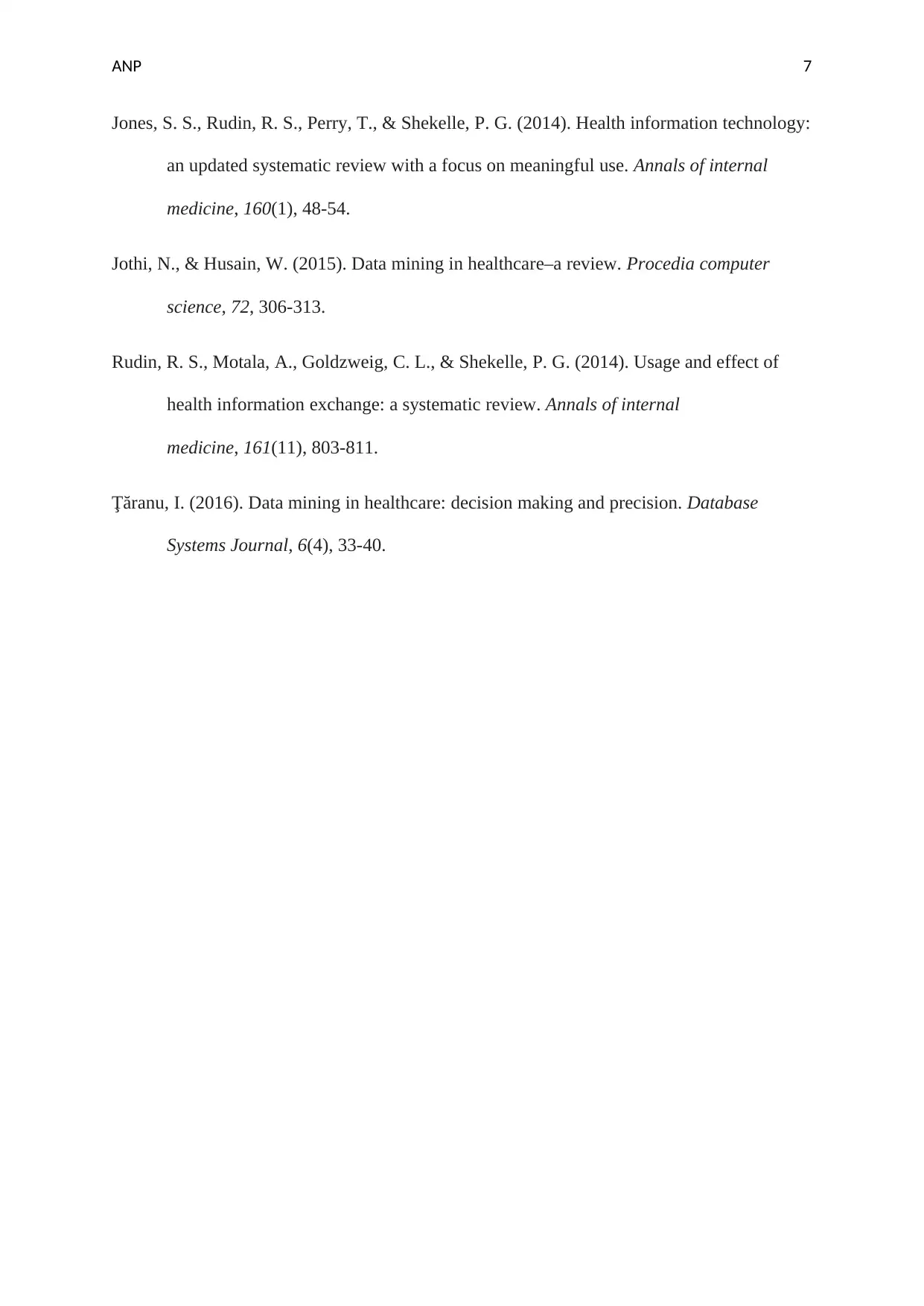
ANP 7
Jones, S. S., Rudin, R. S., Perry, T., & Shekelle, P. G. (2014). Health information technology:
an updated systematic review with a focus on meaningful use. Annals of internal
medicine, 160(1), 48-54.
Jothi, N., & Husain, W. (2015). Data mining in healthcare–a review. Procedia computer
science, 72, 306-313.
Rudin, R. S., Motala, A., Goldzweig, C. L., & Shekelle, P. G. (2014). Usage and effect of
health information exchange: a systematic review. Annals of internal
medicine, 161(11), 803-811.
Ţăranu, I. (2016). Data mining in healthcare: decision making and precision. Database
Systems Journal, 6(4), 33-40.
Jones, S. S., Rudin, R. S., Perry, T., & Shekelle, P. G. (2014). Health information technology:
an updated systematic review with a focus on meaningful use. Annals of internal
medicine, 160(1), 48-54.
Jothi, N., & Husain, W. (2015). Data mining in healthcare–a review. Procedia computer
science, 72, 306-313.
Rudin, R. S., Motala, A., Goldzweig, C. L., & Shekelle, P. G. (2014). Usage and effect of
health information exchange: a systematic review. Annals of internal
medicine, 161(11), 803-811.
Ţăranu, I. (2016). Data mining in healthcare: decision making and precision. Database
Systems Journal, 6(4), 33-40.
1 out of 8
Related Documents
Your All-in-One AI-Powered Toolkit for Academic Success.
+13062052269
info@desklib.com
Available 24*7 on WhatsApp / Email
![[object Object]](/_next/static/media/star-bottom.7253800d.svg)
Unlock your academic potential
Copyright © 2020–2025 A2Z Services. All Rights Reserved. Developed and managed by ZUCOL.





